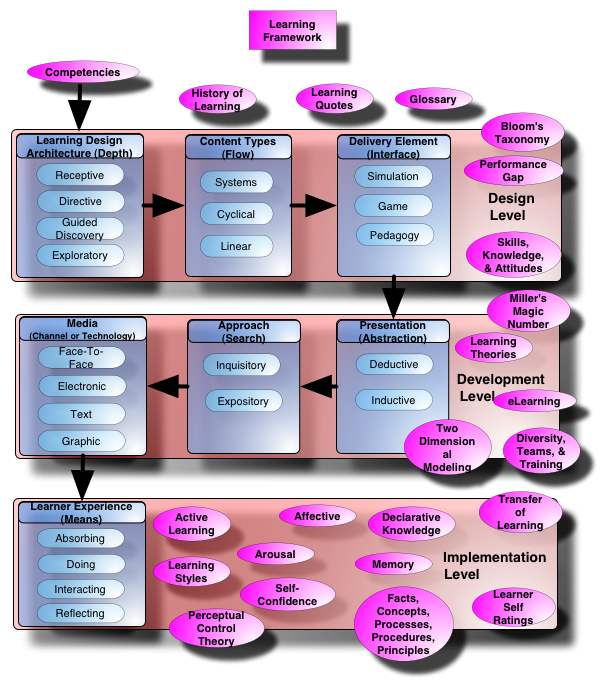Constructivism and Instructional Design
Constructivism is a learning theory, not an instructional approach, hence it can best be thought of as a way of "growing" or improving instruction. It is greatly influenced by Piagetian (1950) epistemology and Lev Vygotsky's (1978) Zone of Proximal Development (ZPD) — knowledge (new connections) are products of the activities practiced in a social environment.
Constructivists place the learner at the center of the equation; the idea is that the learner constructs knowledge rather than passively absorbing it. Meaning is constructed by each learner via their experiences and in their own ways and means. It is based on according to how the learner's understanding is currently organized. An individual's knowledge is a function of one's prior experiences, mental structures, and beliefs that are used to interpret objects and events.
In some classrooms, the predominant training model is direct instruction, which is called instructivism or objectivism (based on information processing theory). The trainer's central role is to transmit knowledge to learners and learner's role is to absorb information (reception and compliance). In this model the trainer's performance is critical. Also, there is a over-reliance on rote memorization, which does not give the learners the skills in how to think and solve problems.
However, in today's real-world context, the work environment is becoming a learning environment (learning organization). Learners will not make use of concepts and ideas unless they use them through some type of process, that is, learners master only those activities they actually practice. Note that this is an assumption in both constructivism and rote learning environments.
Both constructivism and instructivism are required as learners need to be able to solve complex problems and be able to understand the reasons or methods they use to reach their conclusions. Note that this follows Bloom's Taxonomy in that it goes from simple leaning to the higher levels of critical thinking.
Strategies for Using Constructivism in Training
Good interactive strategies enhance the cognitive, social, and emotional climate. Listed below are four activities that are based on constructivism methods.
1. Small Group Activities
In traditional classroom training, small group exercises involves the more conventional notion of cooperation, in that learners work in small groups on an assigned project or problem under the guidance of the trainer who monitors the groups, making sure the learners are staying on task and are coming up with the correct answers (if there is a right or a best answer).This is known as cooperative learning. Collaborative learning is a more radical departure. It involves learners working together in small groups to develop their own answer through interaction and reaching consensus, not necessarily a known answer. Monitoring the groups or correcting "wrong" impressions is not the role of the trainer since there is no authority on what the answer should be.
One small group method is "Numbered Heads Together" developed by Spencer Kagan. This method divides the learners in groups of three to six. Each group is assigned a team number and each group member is assigned a number. When the trainer poses a question, group members get together, examine the possibilities, and construct an answer. The trainer then picks a number by drawing a card or rolling a die. The number selected designates the spokesperson for each table group. A second number designates the table group that will respond first.
Group learning activities cause learners to integrate experiences, knowledge, and beliefs and at the same time, knowledge and beliefs are formed within each learner. While the group activity allows them to gain a new experience.
2. Learner Developed Instruction
Constructivist learning theory also places importance on the learner's point of view. Make a point of including participant requests in the design process. Although it requires extra work, the payback in engagement and learning is well worth the effort. This is because the learners bring some form of prior knowledge to presentations. These conceptions (and misconceptions) should become part of the design process for the experience you are trying to create. A mind map is a good method for helping a learner to present her current theories.
3. Metacognition and Reflection
Metacognition allows the learner to plan, set time lines, allocate resources. Also, metacognition also refers to the ability to reflect on one's own performance. Reflection allows the learners the opportunity to develop, assess, and organize their thoughts.
4. Other Activities
- Ask open-ended questions
- Identify situations where the learners' perceptions vary
- Brainstorm possible alternatives
- Have the learners:
- Look for information
- Experiment with materials
- Observe phenomena
- Conduct experiments
- Design models
- Collect and organize data
- Employ problem-solving strategies
- Select appropriate resources, review, and critique solutions
References
Piaget, Jean. (1950). The Psychology of Intelligence. New York: Routledge.
Vygotsky, L. S. (1978). Mind in society: The development of higher psychological processes. Cambridge, MA: Harvard University Press.




